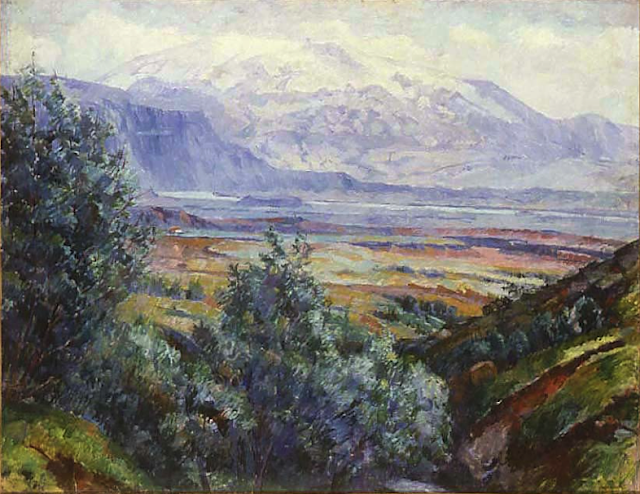
ISAAC LEVITAN (1860-1900)
Le Rocher d'Eze 430m)
France (Provence Alpes Cote d'Azur)
In Corniche. Sud de la France. 1889
Le peintre
Isaac Ilyich Levitan (Исаа́к Ильи́ч Левита́н) est un peintre paysagiste russe. Isaac Levitan naît dans un shtetl, aux abords de Wirballen, dans une famille juive cultivée mais pauvre du gouvernement de Kowno (actuellement en Lituanie). Son père est le fils d'un rabbin, il a suivi une scolarité complète dans une yechiva, et enseigne un temps le français et l'allemand à Kaunas, avant de travailler pour une entreprise française de construction en tant que traducteur. Isaac Levitan s'établit avec sa famille à Moscou au début des années 1870. Le décès de sa mère en 1875 et de son père en 1877 le laissent dans un profond dénuement, mais il parvient à intégrer l'École de peinture, de sculpture et d'architecture de Moscou en 1873 dont on le dispense de payer les frais « vu son extrême pauvreté et en tant qu'élève extrêmement doué pour les arts » Son talent l'aide à terminer ses études avec succès et à gagner une renommée naissante. En 1876, il entre dans l'atelier du peintre Alexeï Savrassov, qui préconise le travail en plein air et l'étude de la nature. Il fait aussi connaître à ses élèves les peintres de l'école française de Barbizon, notamment Jean-Baptiste Camille Corot, que Levitan aime particulièrement. Il est ensuite fortement influencé par le peintre Vassili Polenov, qui enseigne à l'école de 1882 à 1883. Levitan devient plus tard membre des Ambulants, le courant réaliste russe de la fin du XIXe siècle. En 1898, on lui confie la classe de paysage de l'école de peinture, sculpture et architecture. Il s'entretient alors avec ses élèves de littérature et d'histoire de l'art. Il leur enseigne à son tour à peindre en plein air comme le lui enseigna son ancien maître, et leur recommande en outre d'éviter de copier la manière de peindre de tel ou tel maître pour se livrer à une approche plus spontanée et réaliste de la nature. Il se lie d'amitié avec Anton Tchekhov et trouve la protection de Pavel Tretiakov. En 1889-1890, il voyage en France et en Italie. Il meurt en 1900 dans son atelier moscovite de la rue Bolchoï Trekhsviatitelski. Il souffre toute sa vie de problèmes cardiaques, qui causent sa mort. Il fut d'abord enterré au cimetière juif de Dorogomilovo, mais en 1941, ses restes furent transférés au cimetière de Novodiévitchi. Il a laissé une abondante correspodndance avec Anton Tchekov
Le piton
Le
rocher d'Èze est Situé à environ 430 mètres d'altitude, surplombe la
mer Méditerranée et offre des panoramas spectaculaires. sur la Corniche
de Côte d'Azur, notamment sur les baies de Beaulieu, de
Saint-Jean-Cap-Ferrat et de Cap-d'Ail. Le rocher héberge Èze Village et
son Jardin Exotique joyau naturel à ne pas manquer. Pour les
amateurs de randonnée, : le Sentier Nietzsche un chemin escarpé relie
le village perché d’Èze à la plage, offrant une vue imprenable sur la
Méditerranée à travers une végétation méditerranéenne sauvage. Inspiré
par les marches du philosophe Friedrich Nietzsche, il allie effort
physique et contemplation. Le Rocher d'Eze fait partie du Parc Naturel de la Grande Corniche
________________________________________
2025 - Gravir les montagnes en peinture
Un blog de Francis Rousseau
%20-%20Le%20ventoux-%201954-%20Huile%20sur%20carton-%20CP%20Suisse%20.png)



















